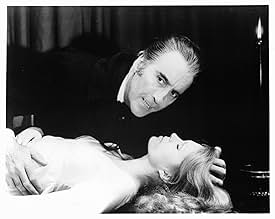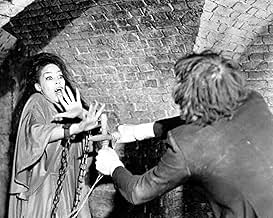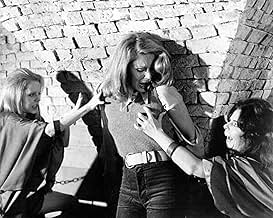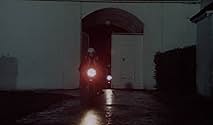NOTE IMDb
5,5/10
7,5 k
MA NOTE
À Londres, dans les années 1970, les enquêteurs de Scotland Yard pensent avoir découvert un cas de vampirisme. Ils font appel au professeur Lorrimer Van Helsing, un expert des vampires.À Londres, dans les années 1970, les enquêteurs de Scotland Yard pensent avoir découvert un cas de vampirisme. Ils font appel au professeur Lorrimer Van Helsing, un expert des vampires.À Londres, dans les années 1970, les enquêteurs de Scotland Yard pensent avoir découvert un cas de vampirisme. Ils font appel au professeur Lorrimer Van Helsing, un expert des vampires.
- Réalisation
- Scénario
- Casting principal
- Récompenses
- 1 nomination au total
Avis à la une
The last of the Christopher Lee Dracula series [the Count would make one more brief return for Hammer in the guise of John Forbes-Robertson in The Legend Of The Seven Golden Vampires] is not exactly a success, but it's a good deal more interesting than the shoddy Dracula AD 1972. There are quite a few new ideas in this one, although they are not organised well and it does become a bit of a mess. However, dull it isn't, unlike the previous one.
We have satanists practising sacrificial rites, a mad scientist with a deadly virus, a Howard Hughes-type recluse who turns out to be....., biker assassins with guns, you name it. Much of it has an Avengers feel, and Dracula is unsurprisingly hardly in the film, with only one brief appearance until the final twenty minutes. There's more action than horror, but two vampire scenes in a cellar are well done. The effects of Dracula's death sequence are excellent, although the scene is silly, with this most accident prone of vampires simply walking into a rose bush.
Not really a good film, but kind of fun. It does suggest interesting pathways which Hammer might have taken the series if the response to this had not been so poor.
We have satanists practising sacrificial rites, a mad scientist with a deadly virus, a Howard Hughes-type recluse who turns out to be....., biker assassins with guns, you name it. Much of it has an Avengers feel, and Dracula is unsurprisingly hardly in the film, with only one brief appearance until the final twenty minutes. There's more action than horror, but two vampire scenes in a cellar are well done. The effects of Dracula's death sequence are excellent, although the scene is silly, with this most accident prone of vampires simply walking into a rose bush.
Not really a good film, but kind of fun. It does suggest interesting pathways which Hammer might have taken the series if the response to this had not been so poor.
I guess Christopher Lee had had enough of Dracula, and this was his swan song. This has a clever twist, bringing the old guy back one more time. It involves the Count trying to bring a plague on humanity by using a group of significant businessmen to do his bidding. Of course, it's the same old crosses made by two sticks of wood, and so on. Cushing does his usual spooky character, this time a latter day Van Helsing. I have to say I enjoyed it.
Hammer's penultimate Dracula film and the last one to feature a tired Christopher Lee in the title role.
This is a significant improvement over Dracula A.D. 1972, but Peter Cushing is used significantly less in the fight scenes (which are not particularly good anyway).
The story, which revolves around a revived Dracula (in disguise) getting government ministers and leading doctors to help him take over the world with the plague has its merits. Infact, the story is well-paced and it's content is refreshingly varied (bike chases, cellars with female vampires, a plague victim etc).
Freddie Jones turns up with a superbly jittery performance as a scientist (he was also excellent in "Frankenstein Must Be Destroyed").
Christopher Lee doesn't get enough screen time, but his scenes with Peter Cushing are, as you might expect, good (n.b. the scene in the tower block where Van Helsing goes to expose D.D. Denham as Dracula). Lee, also gets a chance to utter the immortal lines "..my revenge has spread over centuries and has just begun..." (which is apparently from the book).
If you go into this film with an open-mind, you won't be too disappointed - there is certainly plenty going on, even if the plot is not very tightly structured.
This is a significant improvement over Dracula A.D. 1972, but Peter Cushing is used significantly less in the fight scenes (which are not particularly good anyway).
The story, which revolves around a revived Dracula (in disguise) getting government ministers and leading doctors to help him take over the world with the plague has its merits. Infact, the story is well-paced and it's content is refreshingly varied (bike chases, cellars with female vampires, a plague victim etc).
Freddie Jones turns up with a superbly jittery performance as a scientist (he was also excellent in "Frankenstein Must Be Destroyed").
Christopher Lee doesn't get enough screen time, but his scenes with Peter Cushing are, as you might expect, good (n.b. the scene in the tower block where Van Helsing goes to expose D.D. Denham as Dracula). Lee, also gets a chance to utter the immortal lines "..my revenge has spread over centuries and has just begun..." (which is apparently from the book).
If you go into this film with an open-mind, you won't be too disappointed - there is certainly plenty going on, even if the plot is not very tightly structured.
1973's "The Satanic Rites of Dracula" may have been commissioned by Warner Brothers to fulfill a 2 picture Hammer contract, but with the colossal failure of "Dracula A.D. 1972" and the same production team at the helm (Alan Gibson directing from a Don Houghton script), production would proceed with little confidence as "Dracula is Dead and Well and Living in London." Warners disowned the final product, issued in the US five years after completion with the title "Count Dracula and His Vampire Bride," Christopher Lee's 7th and final appearance in the title role, teamed for the third time with Peter Cushing's Van Helsing, who had destroyed his nemesis in modern day King's Road to conclude "AD," only to learn that the Count was swiftly revived by a new acolyte for a new mission, bringing in the nation's most powerful men in a plot to infect the world with a rapid mutation of bubonic plague. One general, one politician, one landowning Baron, and one Nobel Prize winning bacteriologist are installed under the pretense of using the weapon only as a deterrent, the vampire cult stationed at remote Pelham House, where blood rituals take place and biker guards attired in afghan prowl the grounds with sniper rifles. What a jumbled mishmash, keeping Lee offscreen until the final third, when his initial faceoff with Van Helsing evokes fond memories of past glories, and includes the bilingual Lee's personal tribute to Bela Lugosi by adopting a vaguely Hungarian accent. He remains a shadowy figure seated behind his desk as the reclusive entrepreneur D.D. Denham, the light reflected away to avert suspicion, Van Helsing armed with a silver bullet but not before making inquiries of the mysterious Denham, a helpless captive to witness Dracula's suicidal triumph. The ridiculous ease with which all vampires are dispatched also afflicts the central character himself, denied access to final revenge by the branches of a hawthorn bush (the object of Christ's crown of thorns), sent tumbling into an unworthy demise to quietly expire one last time, as opposed to the finale of "Horror of Dracula," a thunderous music score fully engaging the viewer in its thrilling battle of arch nemeses. The satanic rites themselves are superfluous and take up the entire opening half hour, after which Cushing effortlessly carries the picture on his own while protagonists fall like dominos; he'd be back for a 5th outing in Hong Kong, "The Legend of the 7 Golden Vampires," while Lee concludes his run with more screen time than in any previous Hammer entry except "Scars of Dracula," at least bowing out in a literal blaze of glory.
Hammer's last throw with Christopher Lee who refused to do another Dracula after AD 1972. He regarded the last Hammer's as such a departure from Stoker as to be sacrilegious. This replaces horror with a thriller. Dracula in a thriller? French Connection was a thriller. How does the suave and deadly Count become transplanted into a more style which uses more realism? He cannot, he is incongruous. Consequently Dracula makes almost no appearance until the last 15 minutes. The rest of the film is a chase between his henchmen and Cushing with the police. The quality of the Dracula films had deteriorated in their glamour and stylishness and transferring to the modern day was an attempt to inject glamour again. The most interesting piece of this film is the satanic rite of the title. Its images and practises have been used by the Church of Satan and other occult groups. The actor, scientist and parapsychologist Stephen Armourae has referred to it in articles and the actress Mia Martin has appeared in some of his drawings and paintings. Oddly despite such a high profile release none of the actors including Pauline Peart and Mia Martin did anything since despite their glamour and looks.
Le saviez-vous
- AnecdotesChristopher Lee found himself getting increasingly dismayed and disillusioned that Dracula's portrayal was moving increasingly away from the source material, calling this movie "a mixture of Howard Hughes and Dr. No" in a 1994 interview.
- GaffesIt is not possible to melt silver over a small propane camping gas stove as shown since it has a melting point of about 962 °C. The apparatus loses heat too quickly to achieve such temperatures. Molten metal at such temperatures glows with a white-reddish hue as a function of the temperature instead of remaining silver-colored as shown. It is also not possible to use a lead bullet mold as shown because silver is much harder and more resilient than lead and thus cannot be trimmed off with the mold's trimming cutter as shown.
- Citations
Count Dracula: [to Van Helsing] My revenge has spread over centuries and has just begun!
- Versions alternativesThe original UK cinema print was cut by the BBFC to heavily edit the opening sacrifice scene, 2 staking scenes and the electrocution of a guard (the proposed cuts to the shooting of Torrence were never made). For the video release the same cut print was submitted and cut by a further 1 sec to remove a shot of Jane's exposed breast being pierced with a stake.
- ConnexionsEdited into Haunted Hollywood: Count Dracula and his Vampire Brides (2016)
Meilleurs choix
Connectez-vous pour évaluer et suivre la liste de favoris afin de recevoir des recommandations personnalisées
- How long is The Satanic Rites of Dracula?Alimenté par Alexa
Détails
- Date de sortie
- Pays d’origine
- Langues
- Aussi connu sous le nom de
- The Satanic Rites of Dracula
- Lieux de tournage
- Société de production
- Voir plus de crédits d'entreprise sur IMDbPro
- Durée
- 1h 27min(87 min)
- Rapport de forme
- 1.85 : 1
Contribuer à cette page
Suggérer une modification ou ajouter du contenu manquant






























